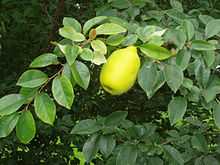Pseudocydonia
| Pseudocydonia | |
|---|---|
 | |
| Pseudocydonia sinensis | |
| Scientific classification | |
| Kingdom: | Plantae |
| (unranked): | Angiosperms |
| (unranked): | Eudicots |
| (unranked): | Rosids |
| Order: | Rosales |
| Family: | Rosaceae |
| Subfamily: | Amygdaloideae[1] |
| Tribe: | Maleae |
| Subtribe: | Malinae |
| Genus: | Pseudocydonia C.K.Schneid. |
| Species: | P. sinensis |
| Binomial name | |
| Pseudocydonia sinensis C.K.Schneid. | |
| Synonyms[2] | |
| |
Pseudocydonia sinensis, the Chinese Quince, is a deciduous or semi-evergreen tree in the family Rosaceae, native to eastern Asia in China. It is closely related to the east Asian genus Chaenomeles, and is sometimes placed in Chaenomeles as C. sinensis,[3] but notable differences are the lack of thorns, and that the flowers are produced singly, not in clusters. It is closely related to the European Quince genus Cydonia,[4] but one notable difference is the serrated leaves.
In China, the species is called "mugua", while in Korea, it is called "mogwa" (hangul: 모과; Chinese/hanja: 木瓜 - not to be confused with "papaya", whose Chinese transliteration is also called 木瓜) which is used for medicine or for making beverages, such as mogwacha.[5] In Japan, it is known as "karin - 花梨" (花 - a flower, 梨 - the pear species, Pyrus pyrifolia', also called "Asian pear," or "nashi").
It grows to 10–18 m tall, with a dense, twiggy crown. The leaves are alternately arranged, simple, 6–12 cm long and 3–6 cm broad, and have a serrated margin. The flowers are 2.5–4 cm diameter, with five pale pink petals; flowering is in mid spring. The fruit is a large ovoid pome 12–17 cm long with five carpels; it gives off an intense, sweet smell and it ripens in late autumn.
Uses
The fruit is hard and astringent, though it does soften and becomes less astringent after a period of frost. It can be used in the same way as quince is used for making jam. It is also grown as an ornamental tree in southern Europe.
The wood of this plant is frequently used in Japan for making low-end Shamisen.
See also
- the flowering quinces, genus Chaenomeles
- the "true" Quince (Cydonia oblonga)
References
- ↑ Potter, D.; Eriksson, T.; Evans, R. C.; Oh, S.; Smedmark, J. E. E.; Morgan, D. R.; Kerr, M.; Robertson, K. R. et al. (2007). "Phylogeny and classification of Rosaceae". Plant Systematics and Evolution 266 (1–2): 5–43. doi:10.1007/s00606-007-0539-9. [Referring to the subfamily by the name "Spiraeoideae"]
- ↑ "USDA GRIN Taxonomy".
- ↑ Gu Cuizhi and Stephen A. Spongberg, 2003. Flora of China (entry under Chaenomeles sinensis)
- ↑ Campbell, C.S.; Evans, R.C.; Morgan, D.R.; Dickinson, T.A.; Arsenault, M.P. (2007). "Phylogeny of subtribe Pyrinae (formerly the Maloideae, Rosaceae): Limited resolution of a complex evolutionary history". Plant Systematics and Evolution 266 (1–2): 119–145. doi:10.1007/s00606-007-0545-y.
- ↑ http://herb.daegu.go.kr/kor/exhibit/herb.info.form.asp?h_code=75 (Korean)
| Wikimedia Commons has media related to Pseudocydonia. |